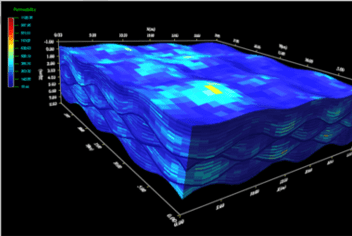Permeability is very difficult to estimate, mainly because it is very scale- and direction dependent. For instance, from permeability measured in core plugs to permeability estimated from well tests, there is a big difference in scale. How to compare these correct and apply further in reservoir computer models, is a...
Estimation of geocell water saturation based on small-scale structures in the Brent Group on the Oseberg and Gullfaks fields
Water saturation in reservoir rocks is highly dependent on petrophysical parameters as permeability, porosity and the amount of clay and shale in the sandstone. Saturations are important for static hydrocarbon volumes and for saturation-dependent flow parameters, such as relative permeabilities. Methods used today to estimate water saturation are usually based...
Geomodeling Releases AttributeStudio™ 7.0
Advanced Microseismic Data Analysis and Seismic-Conditioned Hydraulic Fracture Modeling for Unconventional Oil and Gas Exploration and Production CALGARY, Alberta--(BUSINESS WIRE)--Geomodeling Technology Corp., a leading provider of seismic analysis and cross-scale modeling software for the upstream oil and gas industry, today announced a major new release of AttributeStudio™, its cutting-edge seismic...
Geomodeling Releases SBED™ 4.1 and SBED™ 4.1 for Petrel*
Advanced Software for Near-Wellbore Rock Property Modeling January 28, 2011 CALGARY, Alberta--(BUSINESS WIRE)--Geomodeling Technology Corp., a leading provider of innovative software for the upstream oil and gas industry, today announced the release of SBED™ 4.1 and SBED™ 4.1 for Petrel* near-wellbore modeling applications. SBED 4.1 adds automatic core plug conditioning...
Geomodeling to Make Two Presentations at the International AAPG Conference on Unconventional Exploration
Two papers highlight breakthrough technology for unconventional oil and gas exploration CALGARY, Alberta -- Geomodeling Technology Corp., a leading provider of innovative software for the upstream oil and gas industry,will make two presentations at the International AAPG Conference & Exhibition (ICE) September 12-15 in Calgary, Alberta, Canada. The theme of...
Geomodeling Releases AttributeStudio™ 6.5
Advanced Software for Seismic Attribute Interpretation includes New Features for Unconventional Natural Gas Plays CALGARY, Alberta--(BUSINESS WIRE)--Geomodeling Technology Corp.,a leading provider of seismic analysis and cross-scale modeling software for the upstream oil and gas industry, today announced a new release of AttributeStudio™, its cutting-edge seismic attribute interpretation software. AttributeStudio 6.5...
Statoil Piloting SBED™ Software from Geomodeling, Aiming for a Corporate Standard for Their Multi-Scale Model Workflow
Increases in Oil and Gas Recovery Rate in Norwegian Sea Reservoirs Drives Decision CALGARY, Alberta--(BUSINESS WIRE)--Geomodeling Technology Corp., a leading provider of innovative software for the upstream oil and gas industry, today announced that Statoil is currently piloting the SBED modeling system with the aim of implementing this technology as...
Geomodeling Releases SBED 4.0 and SBED 4.0 for Petrel*
Advanced Software for Near-Wellbore Rock Property Modeling CALGARY, Alberta--(BUSINESS WIRE)--Geomodeling Technology Corp., a leading provider of innovative software for the upstream oil and gas industry, today announced the release of SBED(TM) 4.0 and SBED 4.0 for Petrel* near-wellbore modeling software. SBED provides breakthrough technology that models small-scale sedimentary details and...
Validating Workflows with Pore-Scale Modelling and Fine-Scale Geology for Water Saturation Interpretation
Future workflows for water saturation interpretation in heterogeneous intervals, should take the heterogeneity into account in a robust manner. We want fine-scale geology to be modelled realistically, down towards mm-scale when appropriate, and populate these models with properties from pore-scale modelling. The geologically realistic models can then be upscaled for...
Increasing Geological Accuracy in Reservoir Models through Process-Oriented Modeling
An important task in constructing digital reservoir models is the capture of geological detail with sufficient resolution to reduce the uncertainty inherent in interpolation between discrete data points. Even the most sophisticated mathematical or statistical reservoir modeling algorithm, however; remains ignorant of the processes by which reservoir strata are deposited....




